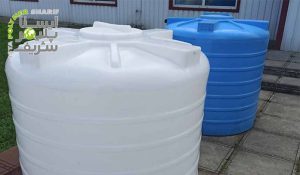Drinking water tanks come in a wide variety. Metal tanks, composite tanks, and polyethylene tanks are widely used across different industries. Polyethylene drinking water tanks are produced in sizes ranging from very small up to 20 cubic meters. The highest usage of these tanks is in the construction and facilities sectors. Polyethylene drinking water tanks are primarily produced using the molding process. These tanks can also be constructed on-site using welding techniques, depending on their location. The polyethylene tanks produced by Iranian ABtank are manufactured using rotational molding with medium-density polyethylene (MDPE) material.
Steps in Manufacturing Polyethylene Drinking Water Tanks
Polyethylene pellets are first converted into powder, which is then melted in the mold and uniformly coated using the rotational molding process. Polyethylene tanks can also be manufactured on-site. These tanks are made from prefabricated sheets of high-density polyethylene (HDPE). The sheet widths are generally 100 and 120 centimeters. The thickness of the tanks varies based on the volume, starting from 10 millimeters and above. After cutting the polyethylene sheets in the workshop or at the project site, they are sewn using polyethylene welding machines and polyethylene rods with a diameter of 3 or 4 millimeters. The welds have high mechanical strength and can withstand high mechanical stress over a long period. Polyethylene tanks made from polyethylene sheets offer high-quality drinking water. These tanks are not only of high quality but also very cost-effective. In addition to storing water under the name water tank, polyethylene tanks can also store fuel and chemicals.






